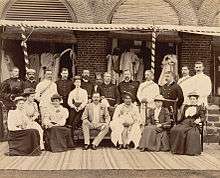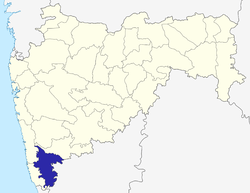Shahu of Kolhapur
| Shahu | |
|---|---|
| Chhatrapati Maharaja of Kolhapur | |
|
Portrait of the Chhatrapati, Maharaja of Kolhapur (1912) | |
| Born | June 26, 1874 |
| Died | May 6, 1922 (aged 47) |
| House | Bhonsle |
| Father | Appasaheb Ghatge.. |
| Mother | Radhabai |
| Religion | Hinduism |
Shahu (also known as Rajarshi Shahu or Chhatrapati Shahu Maharaj) GCSI GCIE GCVO (26 June 1874 – 6 May 1922) of the Bhonsle dynasty, was the Raja 1894-1900 and first Maharaja (1900-1922) of the Indian princely state of Kolhapur.[1][2][3]

Accession

Shahu was born on 26 June 1874 as Yeshwantrao Ghatge, eldest son of Jaishinghrao Ghatge, chief of Kagal (senior) by his wife Radhabai, a daughter of the Raja of Mudhol. He was adopted by Anandibai, widow of Raja Shivaji VI, in March 1884. Several generations of inter-marriage had ensured that Shahu's family was connected intimately with the ruling dynasty of Kolhapur, which is apparently what rendered him a suitable candidate for adoption, despite his not being a male-line member of the Bhosale dynasty. He was educated at Rajkumar College, Rajkot. A council of regency was appointed by the British government of India to oversee affairs of state during Shahu's minority and during that time he was tutored in administrative affairs by Sir Stuart Fraser. Shahu was invested with ruling powers upon coming of age in 1894.[4]
Vedokta controversy
When the Brahmin priests of the royal family refused to perform the rites of the non-Brahmins in accordance with the Vedic hymns, he took the daring step of removing the priests and appointment a young Maratha as the religious teacher of the non-Brahmins, with the title of `Kshatra Jagadguru' (the world teacher of the Kshatriyas). This was known as the `Vedokta' controversy. It brought a hornet's nest about his ears but he was not the man to retrace his steps in the face of opposition. He soon became the leader of the non-Brahmin movement and united the Marathas under his banner.[5][6]
Social reform

Shahu Maharaj is credited with doing much to further the lot of the lower castes, and indeed this assessment is warranted. He did much to make education and employment available to all: he not only subsidized education in his state, eventually providing free education to all, but also opened several hostels in Kolhapur thereby facilitating the education of the rural and low-caste indigent. His educational institutions include Victoria Maratha Boarding School, Miss Clarke Boarding School and Deccan Rayat Sanstha. He also ensured suitable employment for students thus educated, thereby creating one of the earliest Affirmative action (50% reservation to weaker sections) programs in history. Many of these measures were effected in the year 1902 on 26 July.[7] He started Shahu Chhatrapati Weaving and Spinning Mill in 1906 to provide employment. Rajaram college was built by Shahu Maharaja and afterwards it was named after him.[8]
In 1903 he attended the Coronation of King Edward VII and Queen Alexandra, and in May that year he received the honorary degree LL.D. from the University of Cambridge.[9]
Personal life

In 1891, Shahu married Lakshmibai née Khanvilkar (1880–1945), daughter of a Maratha nobleman from Baroda. They were the parents of four children:
- Rajaram III, who succeeded his father as Maharaja of Kolhapur.
- Radhabai 'Akkasaheb' Puar, Maharani of Dewas (senior) (1894–1973) who married Raja Tukojirao III of Dewas (Senior) and had issue:
- Vikramsinhrao Puar, who became Maharaja of Dewas (Senior) in 1937 and who later succeeded to the throne of Kolhapur as Shahaji II.
- Sriman Maharajkumar Shivaji (1899–1918)
- Srimati Rajkumari Aubai (1895); died young
Chhatrapati Shahu of Kolhapur died on May 6, 1922. He was survived by his wife, his elder son Rajaram and his daughter Radhabai.[10]
Full name and titles
His full official name was: Colonel His Highness Kshatriya-Kulawatasana Sinhasanadhishwar, Shrimant Rajarshi Sir Shahu Chhatrapati Maharaj Sahib Bahadur, GCSI, GCIE, GCVO.
During his life he acquired the following titles and honorific names:
- 1874–1884: Meherban Shrimant Yeshwantrao Sarjerao Ghatge
- 1884–1895: His Highness Kshatriya-Kulawatasana Sinhasanadhishwar, Shrimant Rajarshi Shahu Chhatrapati Maharaj Sahib Bahadur, Raja of Kolhapur
- 1895–1900: His Highness Kshatriya-Kulawatasana Sinhasanadhishwar, Shrimant Rajarshi Sir Shahu Chhatrapati Maharaj Sahib Bahadur, Raja of Kolhapur, GCSI
- 1900–1903: His Highness Kshatriya-Kulawatasana Sinhasanadhishwar, Shrimant Rajarshi Sir Shahu Chhatrapati Maharaj Sahib Bahadur, Maharaja of Kolhapur, GCSI
- 1903–1911: His Highness Kshatriya-Kulawatasana Sinhasanadhishwar, Shrimant Rajarshi Sir Shahu Chhatrapati Maharaj Sahib Bahadur, Maharaja of Kolhapur, GCSI, GCVO
- 1911–1915: His Highness Kshatriya-Kulawatasana Sinhasanadhishwar, Shrimant Rajarshi Sir Shahu Chhatrapati Maharaj Sahib Bahadur, Maharaja of Kolhapur, GCSI, GCIE, GCVO
- 1915–1922: Colonel His Highness Kshatriya-Kulawatasana Sinhasanadhishwar, Shrimant Rajarshi Sir Shahu Chhatrapati Maharaj Sahib Bahadur, Maharaja of Kolhapur, GCSI, GCIE, GCVO
Honours
- Knight Grand Commander of the Order of the Star of India (GCSI), 1895
- King Edward VII Coronation Medal, 1902
- Knight Grand Cross of the Royal Victorian Order (GCVO), 1903
- Hon. LLD (Cantabrigian), 1903
- Delhi Durbar Gold Medal, 1903
- King George V Coronation Medal, 1911
- Knight Grand Commander of the Order of the Indian Empire (GCIE), 1911
- Delhi Durbar Gold Medal, 1911
See also
| Wikimedia Commons has media related to Shahu of Kolhapur. |
References
- ↑ "Shahu Chhatrapati Biography - Shahu Chhatrapati Life & Profile". Cultural India. Retrieved 15 May 2016.
- ↑ "Chatrapati Shahu Maharaj (Born on 26th June)". MULNIVASI ORGANISER. 6 May 1922. Retrieved 15 May 2016.
- ↑ Vidyadhar, TNN (22 July 2002). "Gov seeks total make-over of Chhatrapati Shahu Maharaj's image". The Times of India. Retrieved 15 May 2016.
- ↑ "Rajshri Shahu Ji Maharaj: King of Kolhapur, Demolished Brahmanism, First king in India, Bahujan Samaj Party:". Bahujan Samaj Party (in Hindi). 6 May 1922. Retrieved 15 May 2016.
- ↑ "Pune's endless identity wars". Indian Express. Retrieved 1 August 2015.
- ↑ Rajarshi Shahu Chhatrapati Papers: 1900-1905 A.D.: Vedokta controversy. Shahu Research Institute, 1985 - Kolhapur (Princely State).
- ↑ Today, Nagpur (26 July 1902). "Chhatrapati Shahuji Maharaj gave reservation to Bahujan Samaj to the tune of 50% on July 26, 1902 for the first time in history of India". Nagpur Today : Nagpur News. Retrieved 15 May 2016.
- ↑ "Rare photos, letters to offer a glimpse into Rajarshi Shahu Maharaj's life".
- ↑ "University intelligence". The Times (36779). London. 28 May 1902. p. 12.
- ↑ Tapase, G. D. From Mudhouse to Rajbhavan: Autobiography of a Governor. Chandrika M.A. Sadhana Publications, 1983. p. 14.
- "Cultural Revolt in a Colonial Society" by Gail Omvedt, January, 1976
- Entry regarding Maharaja Shahu Chhatrapati on the website of Indian posts
| Shahu of Kolhapur Bhosale Dynasty (Kolhapur line) Born: 26 July 1874 Died: 6 May 1922 | ||
| Regnal titles | ||
|---|---|---|
| Preceded by Himself (as Raja of Kolhapur) |
Maharaja of Kolhapur 1900–1922 |
Succeeded by Rajaram III |
| Preceded by Shivaji VI (as Raja of Kolhapur) |
Raja of Kolhapur 1884–1900 |
Succeeded by Himself (as Maharaja of Kolhapur) |

